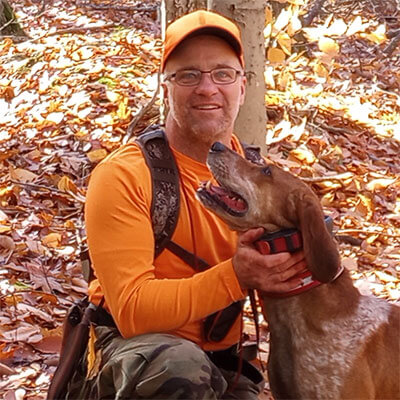- Savage Blog
- Training My Deer Tracking Dog | Red
Training My Deer Tracking Dog | Red
This is a story about my tracking dog, Red. After failing to recover wounded big game animals over the years I decided to train my English Redtick Coonhound to aid me in the search. Once I obtained my New Hampshire leashed tracking license, I wanted to see if Red would track a wounded deer. Red is a registered UKC Coonhound Nite Hunt competition dog. Because of this he was trained not to pursue deer and I was unsure of the outcome. However, Red performed well, and we completed a dozen tracks and recovered three deer. This was the national average recovery rate, so things looked promising.
![]()
In the off season I spent time training Red on drags through the woods. I used a combination of blood and lower front legs that were acquired from deer in 2020. At the end of those drags was a food reward, Red really enjoyed this game.
When the 2021 season started I shadowed a fellow NH Licensed Leashed Tracker on tracks for several weeks. Mable, a Redbone Coonhound, is a highly accomplished big game recovery dog. Red and I simply followed behind Courtney and Mable on 12-15 tracks to show Red what his new job will be. After some time, Red wanted to take the lead on tracks with Mable in tow for backup. This is when I knew it was time to venture out on our own tracks. And that is how it all started.
![]()
Now for the tough part, I had to be trained as Red’s handler! Reading what Red was telling me through his movements and his different vocalizations would determine tracking success. For instance, when he starts yipping under his breath that indicates a live wounded animal is close and it’s time to slow down. If he remains silent, we typically recover an expired animal. Versus if he is wide open barking, that indicates a jumped animal. Nose to the ground, he is intent on the tracks of the wounded animal. Red can note a combination of several scents like gut fluids, blood, and pheromones particular to that deer and the deer’s individual unique scent. Lastly when Red’s head is high, he uses the wind to locate scent and most times starting to finalize the location of the nearby wounded game animal. It took me an entire season to really learn my hound and with mentoring from fellow trackers we have had great success. I couldn’t have done this without my mentor and fellow handlers.
![]()
Each track starts with a phone interview. Archery season is my favorite because the arrow tells the tale. I can evaluate how much time needs to be given for an animal to peacefully expire, resulting in a successful recovery. For example, a liver shot we wait 2-3 hours prior to tracking, a lower gut (stomach) is a 4-6 hour wait, upper gut (intestine) is a 6-12 hour wait, and lung with liver we wait at least 1 hour. Wounds such as shoulder, brisket, and high back are almost always not recoverable, the animal is simply not mortally wounded.
Over the course of two full hunting seasons, we have recovered over 150 big game animals including bear and deer. Given Red’s willingness to please me and his high prey drive he has excelled, I got lucky finding Red. And I feel honored to be involved in each hunter’s big game recovery.
![]()
Here at Savage, we understand that the outcome after the shot is what makes or breaks a season. Oftentimes, not finding an animal leaves the hunter with a remorse that takes a long time to fade. We are lucky that there are folks like Frank and his tracking dog Red out there to help us find our game. Because of them, there have been many hunts rescued, and their dedication shows a great respect for the game we pursue.

